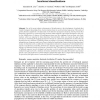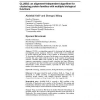249 search results - page 5 / 50 » An Efficient Technique for Protein Sequence Clustering and C... |
BMCBI
2005
13 years 7 months ago
2005
: One of the most evident achievements of bioinformatics is the development of methods that transfer biological knowledge from characterised proteins to uncharacterised sequences. ...
CSB
2002
IEEE
14 years 9 days ago
2002
IEEE
Analyzing protein sequence data becomes increasingly important recently. Most previous work on this area has mainly focused on building classification models. In this paper, we i...
BMCBI
2007
13 years 7 months ago
2007
Background: The genomic revolution has led to rapid growth in sequencing of genes and proteins, and attention is now turning to the function of the encoded proteins. In this respe...
BMCBI
2007
13 years 7 months ago
2007
Background: The pyridine nucleotide disulfide reductase (PNDR) is a large and heterogeneous protein family divided into two classes (I and II), which reflect the divergent evoluti...
IJCBDD
2008
13 years 7 months ago
2008
: CLUSS is an algorithm proposed for clustering both alignable and non-alignable protein sequences. However, CLUSS tends to be ineffective on protein datasets that include a large ...


